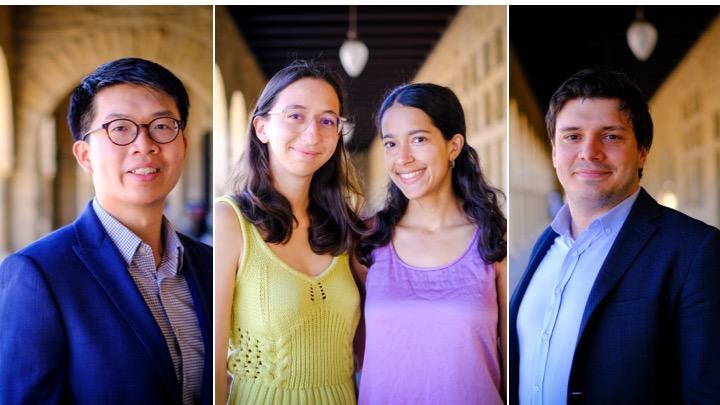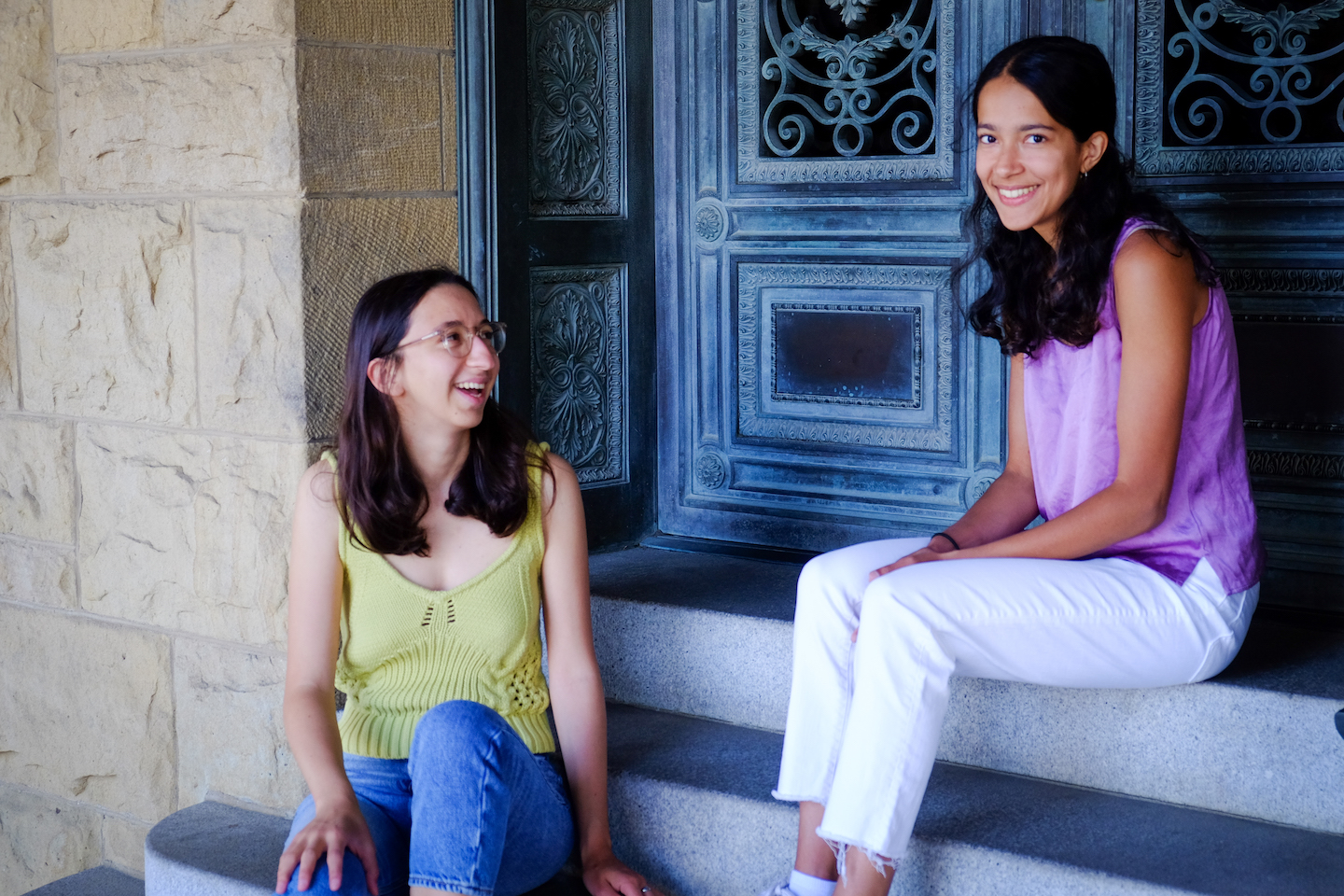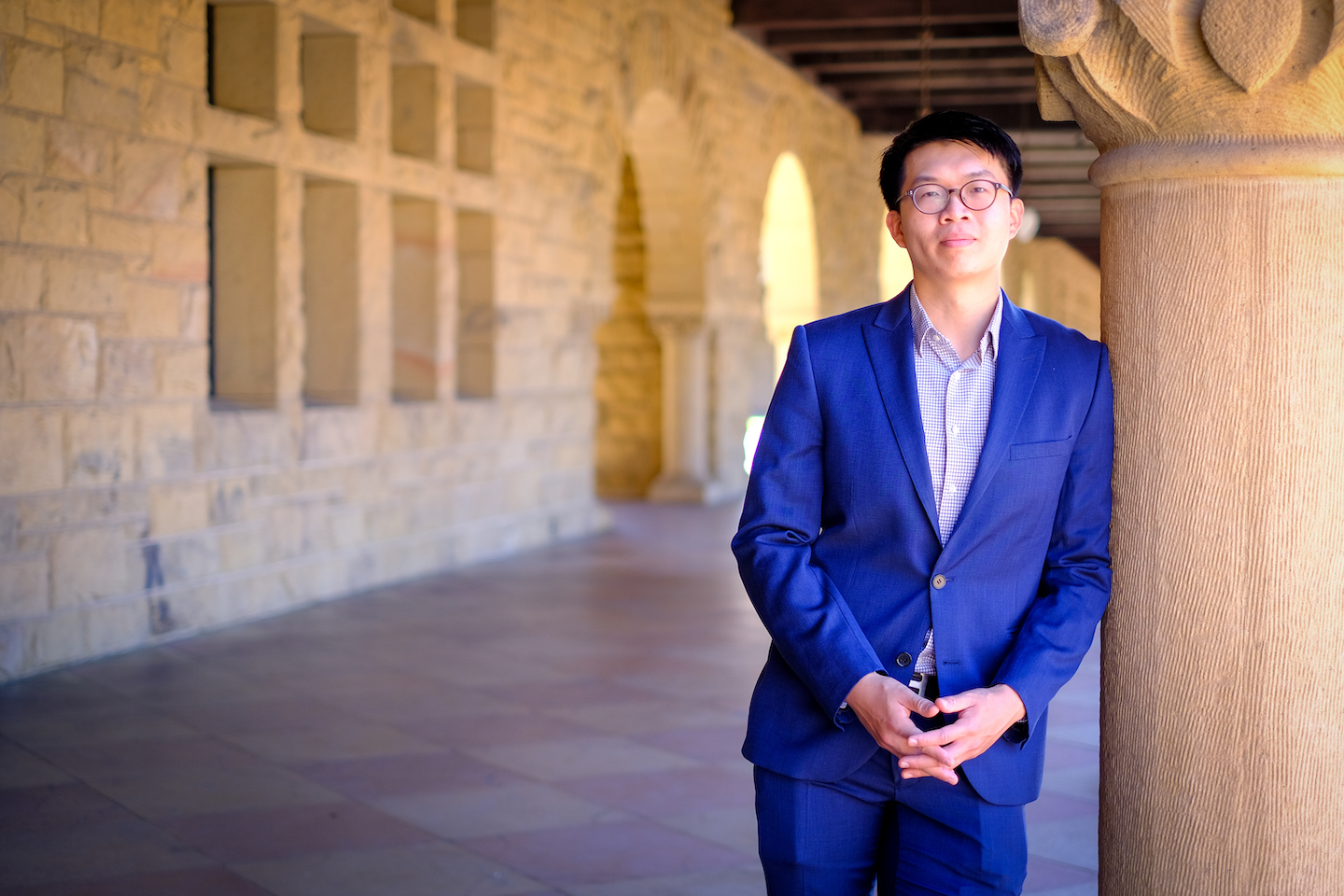
Jeanina Casusi
From left: Wai Tong Chung, Isabelle Levent, Lila Shroff, and Alberto Tono participated in this year's HAI Student Affinity Groups pilot project.
A new program offered by the Stanford institute for Human-Centered Artificial Intelligence (HAI) is giving students across the university an opportunity to explore their ideas on how AI might be used to improve human lives.
The Stanford HAI Student Affinity Groups pilot project was developed to advance HAI’s commitment to bringing a diverse range of voices to AI research, education, and policy, says Vanessa Parli, HAI’s director of research. It invites students from any of Stanford’s seven schools to identify a topic of interest to pursue and recruit their own small group of interdisciplinary teammates. Projects run for the academic year and are eligible for funding of up to $1,000 to cover basic expenses.
“This is an opportunity for students to explore an idea they may have been thinking about but didn’t have a platform or the funding to pursue,” Parli says. “We’re looking for creative, new ideas that only a group of students can come up with.”
Apply here to be considered for the next cohort of Stanford HAI Student Affinity Groups
One of those out-of-the-box ideas was provided by Alberto Tono, a PhD student in civil and environmental engineering and HAI fellow. His team organized a panel discussion with top AI experts moderated by a comedian, who could question panelists in a fresh and relatable way.
“If you want to include everyone in this new moment of AI, it means broadening the conversation to a larger audience and removing as many barriers to participation as possible,” Tono says. “We thought the best way to do that was to put in a comedian, who could ask questions from a completely different perspective to produce a different type of conversation.”
Lila Shroff, a sophomore studying English and symbolic systems, teamed up with friend Isabelle Levent, also a Symbolic Systems Program undergraduate, to co-lead a team examining the effects of generative AI on creative artists.
“We’re both interested in media and AI technology and thought this project could add to our discussions and bring in perspective from the broader Stanford community, whether undergraduates studying in a different field or grad students with more niche experience,” she says.
Wai Tong Chung, a PhD student in mechanical engineering, opted to design a speaker series that brought together varied perspectives on the intersection of AI and climate change.
“For our project, we purposely looked for young Stanford students in different disciplines who could share their varied opinions on this topic,” he says. “We wanted both our group members and our audience to think ‘Hmmm, I never thought about this topic like that’ or ‘I never thought of doing work like that,’ because these varied perspectives demonstrate that there are different paths to take and that’s important for young people trying to make a decision about their career.”
The Student Affinity program will continue in the 2023-24 academic year. Interested students can learn more here.
“This is an investment in the next generation of AI thinkers,” says HAI research associate Christine Raval. “We want to encourage students to explore their ideas and to work collaboratively across disciplines with the goal of ensuring that humanity benefits from this technology and that those benefits are broadly shared.”

AI's Humorous Side
As a PhD candidate in civil and environmental engineering and HAI graduate fellow, Tono is passionate about keeping abreast of technological advancement, but he worries about people less adept who are increasingly having to grapple with new, complex — and sometimes intimidating — technology.
“The current revolution of AI paradigm-shift is forcing everyone to be part of this new wave,” he says. “If we want to include everyone, we have to find a way to establish a more engaging and inclusive conversation.”
Trying to come up with ways to include wider audiences in discussions on AI, Tono turned his eye toward an unusual option.
“I thought the best way to engage with a broader audience might be to put together a question-and-answer panel moderated by a comedian,” he says. “Trevor Noah and John Oliver were among the first to actually present the revolution of AI to a larger audience, and it was really engaging. Comedians can ask questions in different ways and from a different perspective than you might find in a more traditional Q&A setting, and this might be the key to having a more open conversation.”
In his HAI Student Affinity project called “AI Made for All Humans,” Tono and teammates organized a virtual panel discussion led by comedian Irene Tu. The event’s panelists were Microsoft Research Vice President and Distinguished Scientist Ashley Llorens; San Francisco’s Consul General of Italy Sergio Strozzi; IBM AI Ethics Global Leader and Association for the Advancement of Artificial Intelligence President Francesca Rossi; and Stanford Digital Economy Lab Director Erik Brynjolfsson.
A comedian-led panel addressing questions on cutting-edge AI may be unconventional, but it might also prove to be a valuable resource in educating the public on the science and impact of AI development, Tono says.
“Comedians can provide balance; they can look at glowing futuristic predictions with humorous skepticism or point out that we probably should be worried about something,” he says. “They can use a different framework to help people understand the risks and opportunities of AI. More importantly, they can pose research questions in a novel and insightful way even for scientists and researchers. I think we achieved that with this project, and I hope we can do it again, next time with an in-person event.”

Creative Expression in an AI Age
Shroff and Levant, two undergraduate students studying symbolic systems, share a strong common interest in the convergence of media and technology. When they learned about HAI’s Student Affinity Groups, it seemed like a way to push their interest and conversations forward.
“I really enjoy fiction writing, and Isabelle is a filmmaker,” Shroff says. “We knew we were both interested in the intersection of creative work and artificial intelligence, and we thought this program would be a great way to bring other perspectives to the conversation. We wanted to hear not just what the two of us were thinking on these topics, but what people from the broader Stanford community were talking about.”
They created their project, “Generative AI and the Future of Creative Expression,” in collaboration with team members ranging from English undergraduates to computer science PhD students. Over the course of the 2022-23 academic year, the group examined the rapidly increasing use of generative AI in artistic creation and the social and cultural implications of these new creative tools. “We were interested in questions like ‘What does it mean for a machine to be creative?’ and ‘What are artists’ perspectives on these technologies?’ ” says Shroff.
The project produced a curated reading list; an interview series profiling individuals working at the intersection of AI and creative expression; two workshops for the Stanford community featuring artists who use AI tools; and a campus survey gauging student awareness and attitudes toward the use of AI tools in the arts. Shroff and Levant also authored a position paper titled “The Model is the Message,” which examines growing concerns over the centralization of large language models and was presented at the In2Writing workshop at the 2023 ACM CHI Conference on Human Factors in Computing Systems, in Hamburg, Germany.
“This project’s most important takeaway for me was the idea that artists in many ways are at the forefront of the tensions people are feeling about AI and job displacement because their work is being used without compensation to train models that are then being put in direct competition with them,” Shroff says. “But it’s exciting to see people engaging really critically and thoughtfully on this problem and pushing for more artists to be in the room with those who are developing this technology and making policy. Bringing that interdisciplinary format into those spaces is critical.”

From Wind Tunnels to Sustainable Beer
Among mechanical engineering PhD student Chung’s many interests is climate change and its intersection with artificial intelligence, but his ongoing research doesn’t always allow him to explore these ideas with others in different disciplines.
“I focus a lot on partial differential equations and algebraic symbols, and it’s easy to get stuck in the weeds in this kind of field because you’re so focused on detail,” he says. “I wanted to create a speaker series that would encourage people with different perspectives on this topic to come together and share their opinions on what they think is important.”
Chung, who is also a graduate fellow at HAI, and his project co-leader Greyson Assa, a graduate student in Sustainability Science and Practice, assembled a small interdisciplinary team that also included graduate students in aeronautics and astronautics. Together, they organized a series of speakers from academia and industry who discussed topics ranging from the potential of foundation models to help solve climate problems to the use of AI in the beer industry to improve company sustainability efforts, productivity, and sales.
“This project really broadened my experience,” Chung says. “For example, I had never considered the importance of climate change from a business perspective before, since most of my work is focused on government and academic missions. I also learned that the type of work in AI can really differ depending on the discipline. A climate engineer may have to set up wind tunnels and test beds and measuring devices for a project, for example, while economists studying electricity consumption in Uganda would have to spend two years of their PhD building connections with rural communities to complete their project. It made me realize that there are many ways different people can contribute to solving these big problems, and that makes me value diversity a lot more.”
Photos by Jeanina Casusi
Stanford HAI’s mission is to advance AI research, education, policy and practice to improve the human condition. Learn more.